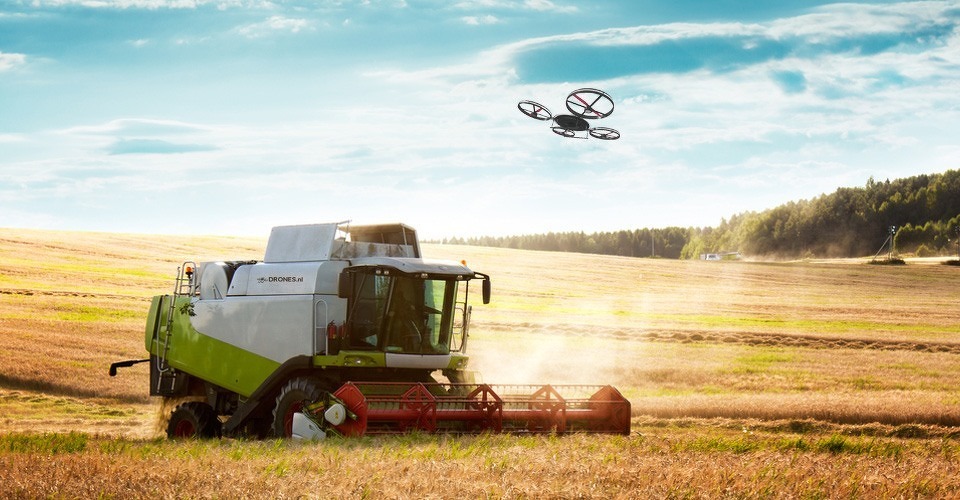Drones are being used in many situation. People use drones to film festivals, fight wars, and deliver packages. Nowadays a new drone implementation is growing: the agricultural sector. According to Kivits (2019), global warming will have many effects on the agricultural sector of which one is the growing amount of insects. These insects could destroy large fields of crops. Therefore, new technologies need to be an answer to this issue and drones could be one of them. Pesticides need to be sprayed onto the crops to avoid insects from settling and destroying the potential harvest. Nowadays, large agricultural vehicles are used to spray the pesticides on the crops, but using drones instead could make the process more precise. Moreover, these drones mostly operate autonomous, relieving the farmer from having to drive across many acers of land to make the job done. The technology is in the lift since the in 2015 released Agras MG-1 drone could do 3 to 4 acres of land per hour. In 2019, the AG V6+ drone was released that could do 7 acres of land per 30 minutes (Kivits, 2019). Meaning that the technological advancements are occurring in a fast pace.
Furthermore, according to Drones.nl (nd.), there are more implications possible that could serve the agricultural sector. DJI Airworks that could support the farmer by examining the health of the crops and to map the soil quality. This health examination could be per individual plant or per field of plants. In addition, it is also possible to detect weeds and insects that could possibly harm the crops.
In conclusion, drones could be a solution to many more problems than just firing rockets. From spraying pesticides, to investigating the health of the crops, to measuring the soil quality. As can be seen in the pesticide spraying example, the technology improves on in a very fast rate. So what will the future hold for the farmers of the future?
Sources:
Drones.nl, nd., DJI introduceert nieuwe Phantom 4 Multispectral: gericht op agrarische sector. Drones.nl [Online]. Available at: https://www.drones.nl/nieuws/2019/09/dji-introduceert-nieuwe-phantom-4-multispectral-gericht-op-agrarische-sector.
Kivits, N., 2019, Drones rukken op in het boeren bedrijf. KIJK Magazine [Online]. Available at: https://www.kijkmagazine.nl/tech/landbouwdrones/.


Dear Bas,
I really liked the topic of your post. Agriculture is by far one of the most important industries in the EU alone, because the worldwide food production needs to double by 2050 in to cater for the population growth and the evolving food habits (Eurostat, 2019). As such, your blog post presents a positive example of how technology and data can help achieve this sustainable goal. Manufacturing and operating drones emits by far less CO2 in comparison with the same processes applied to agricultural machines. Drones have once again proven to be a sustainable replacement of the traditional ways that farmers are used to foster their crops. I believe that soon we will witness a revolution of the whole agricultural industry, in which drones will start assisting farmers on a large scale. If this turns out to be true, then we are definitely on the right track of fighting towards global warming.
References:
Eurostat (2019). Vibrant rural areas and quality agricultural products. Available at: https://europa.eu/european-union/topics/agriculture_en.
Hello Bas!
Thank you for giving us an insight on the so rapid developments in the agricultural industry. Here, the danger of pesticides end ending up in the water supply is reduced through the increased precision of UAVs / drones. You are right, it does not end there though. Aside from the soil and field analysis, drones can also be used to plant crops. Drone-planting systems actually decrease planting costs by 85%, whilst achieving an uptake rate of 75% (Technology Review, 2016). Drones can also assess the health of plants, by scanning how much green and NIR light a plant reflects back (Technology Review, 2019), based on this either irrigation or amount of pesticides can be adapted.
Another interesting viewpoint, is given by Sensefly (2019), who state that the data gathered by drones can support farmers in the case of insurance claims! Drones are able to accurately capture and report crop injuries or destruction that lead to economic loss. However, ethical issues remain as houses and town close to villages may experience disruptions in their privacy (DW, 2019). This shows how interconnected various industries and issues are.
Best regards,
Celina
Sources:
Technology Review (2019). Six Ways Drones Are Revolutionizing Agriculture. [online] Available at: https://www.technologyreview.com/s/601935/six-ways-drones-are-revolutionizing-agriculture/
Sensefly (2019). Why Use Agriculture Drones? [online] Available at: https://www.sensefly.com/industry/agricultural-drones-industry/
Deutschewelle (2019). Next generation farming: How drones are changing the face of British agriculture. [online] Available at: https://www.dw.com/en/next-generation-farming-how-drones-are-changing-the-face-of-british-agriculture/a-49243454